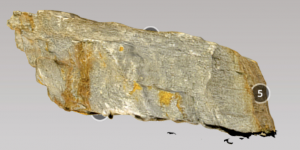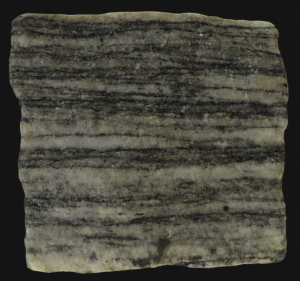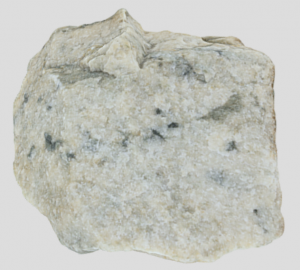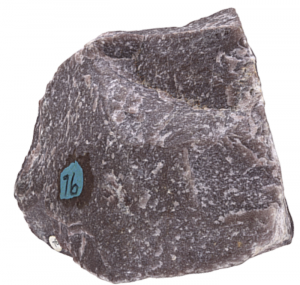7.5 Metamorphic Rock Field Guide
Metamorphic Rock Field Guide
Slate

“SLAYTE”
Most commonly confused with: Shale, Phyllite
A foliated, low-grade metamorphic rock. Slate is fine-grained and composed of clays, and mica minerals that are usually too small to see with the naked eye. Slate displays strong foliation in thin sheets or layers that sometimes resemble sedimentary bedding or the linae of shale. It is usually dark gray in color, but it can also be red, green, brown, and even blue.
Although slate often forms from shale and bears a strong resemblance to this parent rock, its foliation pattern is typically more pronounced. Slate is also sometimes confused with a higher grade metamorphic rock, phyllite, which contains visible grains of mica minerals.
Slate will easily break into sheets along its foliation planes but the silicate minerals that compose its fine-grained structure make it durable against physical weathering processes directed perpendicular to the foliation line. Slate is therefore used as a building material for roofs and tiles in construction.
Phyllite

“FY-LITE”
Most commonly confused with: Slate, Schist
A foliated, low to medium-grade metamorphic rock. Phyllite is fine-grained and composed mostly of quartz, feldspar, and visible flakes of mica minerals. These enlarged mica crystals give phyllite a shimmering or silky appearance under light. Phyllite, like slate, is foliated with thin sheets that sometime separate into uneven layers that give an individual rock a wavy appearance.
The color of phyllite is often gray, black, tan, or green, and it is sometimes confused for either slate or schist. Phyllite can generally be thought of a version of slate that has undergone more metamorphism; it can be distinguished from slate by its visible, glittering mica minerals. By contrast, phyllite can very broadly be thought of as the lower-grade version of schist. Schist has much larger, foliated plates of mica.
Schist
“SHIST”
Most commonly confused with: Phyllite
A foliated, medium-grade metamorphic rock. Schist contains large, leaflike grains of mica such as muscovite and biotite, that are strongly oriented into a single direction. Some varieties of schist have garnets, which only form at elevated temperatures and pressures, although most schists also contain quartz and feldspar. Due to the presence of large mica plates and their flattened orientation, schist is usually shiny or vitreous under light.
Schist is often gray or brown in color, and it is sometimes confused with phyllite, which contains smaller grains of mica. Schist can also be identified by its strong foliation pattern, which is called “schistosity”. This pattern is much more pronounced than lower grade metamorphic rocks such as slate and phyllite.
Gneiss

“NICE”
Most commonly confused with: Granite, Diorite
A foliated, high-grade metamorphic rock. Gneiss has a visible separation of light and dark bands, which is called lineation. Gneiss is coarse-grained and mostly contains silicate minerals that are resistant to high temperatures such as quartz, feldspar, biotite, and garnet. The banding pattern on gneiss is usually wavy or folded, which reflects how the parent rock deformed like putty at extremely high temperatures and pressures; indeed, sometimes the rock partially melts.
Gneiss is occasionally mislabeled as the igneous rock granite or diorite. Although gneiss may contain similar silicate minerals as these rocks, it is distinctively banded, whereas the igneous rocks are granular and have no preferred orientation. Because gneiss is not easily broken into sheets, it is a useful construction material in landscaping and architecture.
Marble

Most commonly confused with: Quartzite
A non-foliated metamorphic rock. Marble forms under low grade or high-grade metamorphism, although at the latter it will grow larger, more interlocked crystals that reflect its higher temperature and pressure origins. The parent rock of marble is limestone, although marble typically appears to have more identifiable grains. Marble contains the mineral calcite and/or dolomite, and it may fizz with dilute hydrochloric acid.
Marble is light in color, and it can be white, pink, tan, or gray. Some varieties of marble look similar to another non-foliated metamorphic rock, quartzite. However, the minerals calcite and dolomite that primarily compose marble are much softer than those found in quartz, and marble is easier to scratch with an iron nail.
Although marble that contains calcite will react to acidic rainwater and groundwater over long periods of time, marble has traditionally been a sculpting material in art and architecture for thousands of years. Polished material remains a popular building and decorative material to this day.
Quartzite

Most commonly confused with: Marble, Sandstone
A non-foliated, high-grade metamorphic rock. Quartzite only forms from the sedimentary rock sandstone, and it almost exclusively contains quartz. The high temperatures and pressures in the metamorphic environment have caused the individual quartz grains to increase in size and interlock.
Quartzite is usually light tan or pink in color and coarse-grained. Like other rocks that predominately contain silica, it can display conchoidal fracture, although it is very resistant to mechanical breakage. Although this rock can look similar to marble, it will not fizz in contact with dilute hydrochloric acid, and it will not easily scratch.
Quartzite is also more durable than its parent rock, sandstone, which weakly cements sand grains together. For example, if sandstone is hit with a rock hammer, the individual grains will remain intact and the cement would crumble. If quartzite is hit with a rock hammer, it would probably spark from the friction and cause the hammer to bounce back, and, thus, is NOT recommended!
Quartzite will resist both chemical and physical weathering. As such, this rock has been used for thousands of years as a tool, construction, manufacturing, and architectural material.
***See 7.6 for Text and Media Attributions
A clastic sedimentary rock made of very fine-grained sediments such as muds, clays, and silts.
A foliated, low to medium-grade metamorphic rock that typically has visible flecks of mica, which causes a "shimmer"-like quality.
A type of metamorphic texture in which the rock has repetitive layering or minerals lined along a preferred direction due to the uneven application of heat and pressure.
A foliated and fine-grained, low-grade metamorphic rock that is originally made from shale.
A group of silicate minerals that typically forms after existing rocks and minerals, such as feldspars, are chemically altered by water.
A group of silicate minerals called the "sheet" silicates. Mica minerals have their atomic structure arranged to easily pull apart as sheets in one direction.
rocks that cement together from weathering products, either from sediments or chemical ions in water.
An original rock from which a new rock (usually metamorphic) is formed.
A mineral class that is primarily composed or defined by silicon (Si) and oxygen (O).
A type of weathering that involves the abrasion and breakdown of existing rocks and minerals by water, the atmosphere, and biosphere. Also known as mechanical weathering.
A strongly foliated, medium-grade metamorphic rock with large, leaf-like grains of mica and sometimes red garnets.
A very common rock-forming silicate mineral with formula SiO2.
A group of silicate minerals which represents the most abundant mineral class of the continental crust.
A common mineral in the mica group that is light grayish-brown. It is flaky and peels apart in sheets.
A type of mica that is black or dark-colored and is typically found in igneous and metamorphic rocks.
X3Y2(SiO4)3
A group of hard silicate minerals that form under high pressures and temperatures. Garnets can have dodecahedral habit and are commonly found in metamorphic rocks, such as schist.
Reflective and glassy luster.
A felsic, intrusive rock with coarse-grained texture. Granite composes mountain cores and can be found on and within the continental crust.
An intermediate, extrusive igneous rock that is coarse-grained. The presence of large black and white crystals on the rock have a "dalmation"-like appearance.
A foliated, high-grade metamorphic rock distinguished by its strong preferred orientation, or banding, of light and dark minerals.
The strong preferred orientation of mineral grains in a metamorphic rock, which is seen as a banding or separation of light and dark minerals. Lineation is categorized under the umbrella term "foliation".
Rocks that crystallize from molten materials beneath the Earth surface or from volcanic processes.
A non-foliated (granoblastic) metamorphic rock that was once a quartz-rich sandstone.
A type of metamorphic rock texture that indicates the lack of layering or preferred alignment of minerals. Non-foliated rocks are granular and usually contain interlocking mineral grains. Also known as granoblastic.
A non-foliated metamorphic rock that forms from limestone.
An organic or chemical sedimentary rock that is primarily composed of calcium carbonate (CaCO3). Limestone is a subgroup of rocks that includes chalk, coquina, and fossiliferous limestone.
CaCO3
A carbonate mineral that strongly reacts with dilute acid. Calcite composes the sedimentary rock limestone and composes the skeletons of some ocean life.
A carbonate mineral, CaMg(CO3)2, that is more resistant to weathering by acid at room temperatures. Dolomite often composes the material of fossilized shells.
A type of clastic sedimentary rock that is composed of sand-sized clasts.
a compound composed of silicon and oxygen in the formula SiO2.
The breakage of a rock or mineral that forms smooth, curved surfaces.
The process in which fluids, such as water, move into the pore spaces between loose sediments and - through chemical reactions - act as a bonding agent between the grains.
The dissolution, disintegration, and alteration of preexisting rock by reactions that take place at the molecular scale.

